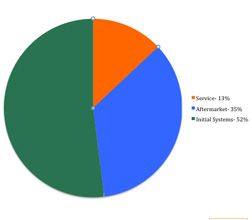Amino Acid Analyzers
The techniques involved in successfully separating and quantifying the amino acids vary from instrument to instrument. However, the processes for amino acid analysis are similar, involving hydrolysis, labeling, separation, and detection followed by data analysis.
The techniques involved in successfully separating and quantifying the amino acids vary from instrument to instrument. However, the processes for amino acid analysis are similar, involving hydrolysis, labeling, separation, and detection followed by data analysis.

2008 Amino Acid Analyzers Market Demand by Product Type
In the traditional method for breaking down proteins for amino acid analysis, the protein or peptide sample is first hydrolyzed in a vacuum or inert atmosphere. A gradient of buffers elutes the sample, which then passes through a resin-packed ion-exchange column. The ninhydrin reagent is applied turning the primary amino acids a bluish color and the secondary amino acids brownish-yellow.
The ramifications of this automated technique, which was first pioneered by Nobel laureates Stanford Moore and William Stein in 1958, have influenced research in areas such as nutritional analysis of animal feed, quality control of pharmaceuticals, and detection of amino acid deficiency disorders.
Amino acid analyzers are used for maintaining high manufacturing standards in the food industry. By testing specific amino acid profiles in fruit juice, for instance, scientists are able to determine not only the origin of the fruit and the conditions in which it was processed, but also the climate in which the fruit grew and how ripe it was when squeezed.
In dairy products, analyzers can detect the presence of unwelcome protein compounds, and, as a result, verify the purity and freshness of a batch of milk. A thorough amino acid analysis can also guarantee the safety of products that are particularly susceptible to contamination and for products that consumers demand the highest degree of reliability, such as baby formula.
The market growth has slowed in the past several years due to increased competition from alternative methods like capillary electrophoresis and mass spectrometry. The AAA market demand is expected to be driven by replacements of legacy systems and strong growth from the food and beverage industry.
The foregoing data was extracted and adapted from SDi's recently published report, Liquid Chromatography: User Requirements Force Adjustments. For more information, contact Glenn Cudiamat, VP of Research Services, Strategic Directions International, Inc., 6242 Westchester Parkway, Suite 100, Los Angeles, CA 90045, tel. (310) 641-4982, fax (310) 641-8851, e-mail:cudiamat@strategic-directions.com
Regulatory Deadlines and Supply Chain Challenges Take Center Stage in Nitrosamine Discussion
April 10th 2025During an LCGC International peer exchange, Aloka Srinivasan, Mayank Bhanti, and Amber Burch discussed the regulatory deadlines and supply chain challenges that come with nitrosamine analysis.
Top Execs from Agilent, Waters, and Bruker Take the Stage at J.P. Morgan Healthcare Conference
January 16th 2025The 43rd Annual Healthcare J.P. Morgan Healthcare Conference kicked off in San Francisco earlier this week. Here’s what top executives from Agilent, Bruker, and Waters, discussed during the event.

.png&w=3840&q=75)

.png&w=3840&q=75)



.png&w=3840&q=75)



.png&w=3840&q=75)



